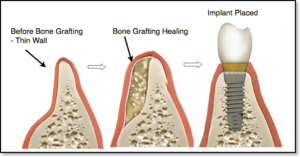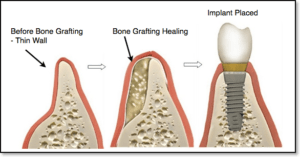
The necessity of a bone graft for a dental implant depends on individual circumstances. If the jawbone lacks thickness or density, making it unable to support an implant, a bone graft may be required. This procedure augments the jawbone, ensuring a sturdy base for the implant. Bone loss due to periodontal disease, trauma, or tooth extraction might also prompt a bone graft to rebuild weakened areas. However, not all cases demand a bone graft for a dental implant. Consulting with a qualified dentist or oral surgeon is crucial to determine the specific needs based on the quality and quantity of the jawbone.

Is Bone Graft Necessary for Dental Implant?
Dental implants have become a popular solution for replacing missing teeth. They offer a permanent and natural-looking option that can restore your smile and improve your oral health. However, in some cases, a bone graft may be necessary before the implant procedure.
What is a Bone Graft?
A bone graft is a surgical procedure that involves taking a piece of bone from another part of your body or using a synthetic or donor bone and grafting it onto your jawbone. This is done to create a solid and stable foundation for the dental implant. The graft acts as a support structure for the implant to anchor onto, ensuring its long-term success.
Reasons for Bone Grafting
There are several reasons why a bone graft may be necessary before a dental implant can be placed:
1. Insufficient Jawbone Density: In some cases, the jawbone may not have enough density or volume to support an implant. This can be due to factors such as tooth loss, gum disease, or bone resorption. A bone graft helps to build up the jawbone and provide the necessary support for the implant.
2. Loss of Jawbone: When a tooth is lost, the surrounding bone can begin to deteriorate over time. This can result in a loss of jawbone height and width. A bone graft can help restore the lost bone and create a stable foundation for the implant.
3. Periodontal Disease: Advanced periodontal disease can lead to bone loss in the jaw. If the disease has caused significant damage to the bone, a bone graft may be necessary to rebuild the area and support the implant.
4. Trauma or Injury: If you have experienced a facial trauma or injury that has damaged the jawbone, a bone graft may be required to repair the area before an implant can be placed.
The Bone Grafting Process
The bone grafting process typically involves several steps:
1. Consultation and Evaluation: Your dentist or oral surgeon will evaluate your oral health, jawbone density, and overall suitability for a dental implant. X-rays or CT scans may be taken to assess the condition of your jawbone.
2. Bone Source: Depending on your specific needs, the bone graft material may be taken from your own body (autograft), a donor (allograft), or a synthetic material (alloplast). Your dentist will discuss the best option for you.
3. Graft Placement: During the surgery, the bone graft material is placed onto the affected area of the jawbone. It is secured in place with screws or pins, and then covered with a membrane to protect the graft as it heals.
4. Healing and Integration: Over the next several months, the bone graft will integrate with your existing jawbone, creating a strong and stable foundation. During this time, you will need to follow a strict oral hygiene routine and avoid putting excessive pressure on the graft.
Benefits of Bone Grafting
Bone grafting offers several benefits for patients who require a dental implant:
1. Improved Implant Success: By providing a solid foundation, bone grafting significantly increases the success rate of dental implant procedures.
2. Preservation of Facial Structure: Bone loss in the jaw can lead to changes in facial appearance and a sunken appearance. Bone grafting helps preserve the natural contours of the face.
3. Enhanced Oral Function: A stable and secure implant allows for improved chewing and speaking abilities, restoring normal oral function.
4. Long-Term Solution: With proper care, dental implants can last a lifetime. Bone grafting ensures the longevity and stability of the implant.
In conclusion, while a bone graft may be necessary for some dental implant cases, it is an essential procedure that provides a solid foundation for long-term implant success. Your dentist will evaluate your specific needs and determine if a bone graft is necessary in your case. It is important to follow their recommendations and ensure the best possible outcome for your dental implant procedure.
Key Takeaways: Is Bone Graft Necessary for Dental Implant?
- 1. Bone grafting may be necessary if there is not enough bone to support a dental implant.
- 2. The procedure involves taking bone from another part of the body or using synthetic materials to build up the jawbone.
- 3. Bone grafting can improve the success and longevity of dental implants.
- 4. Not all dental implant cases require bone grafting, as it depends on the individual’s bone quality and quantity.
- 5. Consulting with a dental professional is essential to determine if a bone graft is necessary for your dental implant.
Frequently Asked Questions
Question 1: What is a bone graft and why is it necessary for a dental implant?
A bone graft is a procedure in which bone material is transplanted to a specific area to help regenerate new bone growth. In the context of dental implants, a bone graft may be necessary when the patient’s jawbone lacks sufficient density or volume to support the implant. This can occur due to factors such as tooth loss, gum disease, or bone resorption.
The purpose of a bone graft is to provide a solid foundation for the dental implant. By augmenting the jawbone with grafting material, the implant can be securely placed and integrated with the surrounding bone, ensuring long-term stability and success of the implant.
Question 2: How is a bone graft performed for a dental implant?
The process of a bone graft for a dental implant typically involves several steps. Initially, the dentist will assess the patient’s jawbone through imaging techniques to determine the extent of bone loss and the ideal grafting approach. The grafting material, which can be sourced from the patient’s own body or a synthetic substitute, is then placed at the deficient area of the jawbone.
Over time, the grafting material stimulates new bone growth, allowing the jawbone to become denser and stronger. Once the graft has successfully integrated with the existing bone, the dental implant procedure can be performed with a higher chance of success.
Question 3: Are bone grafts always necessary for dental implants?
No, bone grafts are not always necessary for dental implants. In some cases, patients may have sufficient jawbone density to support the implant without the need for grafting. However, it is essential to consult with a dental professional to determine whether a bone graft is required in your specific case.
The need for a bone graft depends on various factors, including the quality and quantity of the existing bone, the location of the implant, and the overall oral health of the patient. A thorough examination and evaluation by a dentist or oral surgeon will help determine the best course of action for your dental implant procedure.
Question 4: Does a bone graft prolong the dental implant process?
Yes, a bone graft can extend the overall timeline of the dental implant process. After a bone graft procedure, it takes time for the grafting material to integrate with the jawbone and promote new bone growth. This healing period can vary depending on the individual, but it typically takes several months.
Once the graft has successfully incorporated with the jawbone, the dental implant surgery can be performed. However, it is important to note that the healing and osseointegration process of the implant itself also requires time. Therefore, while a bone graft may add some additional time to the overall process, it is crucial for ensuring the long-term success and stability of the dental implant.
Question 5: Are there any alternatives to a bone graft for dental implants?
Yes, there are alternative treatment options available for individuals who do not have sufficient jawbone density for a traditional bone graft. One alternative is a mini dental implant, which is a smaller version of a regular dental implant and requires less bone structure for support.
In some cases, a dentist may also recommend a sinus lift procedure, which involves elevating the sinus membrane to create additional space for the implant in the upper jaw. This can provide the necessary support without the need for a bone graft.
It’s important to consult with a qualified dental professional to determine the most suitable treatment option based on your specific oral health condition and needs.
Do I need Bone Grafting for my Dental Implant?
Final Thoughts: Is Bone Graft Necessary for Dental Implant?
Call or Book appointment online
:Ace Dental Care Alpharetta office: 678-562-1555 - Book Now
Ace Dental Care Norcross office: 770-806-1255 - Book Now
Disclaimer
This blog post was generated by artificial intelligence. The content of this post may not be accurate or complete, and should not be relied upon as a substitute for professional advice. If you have any questions about the content of this post, please contact us.
We are constantly working to improve the accuracy and quality of our AI-generated content. However, there may still be errors or inaccuracies. We apologize for any inconvenience this may cause.





